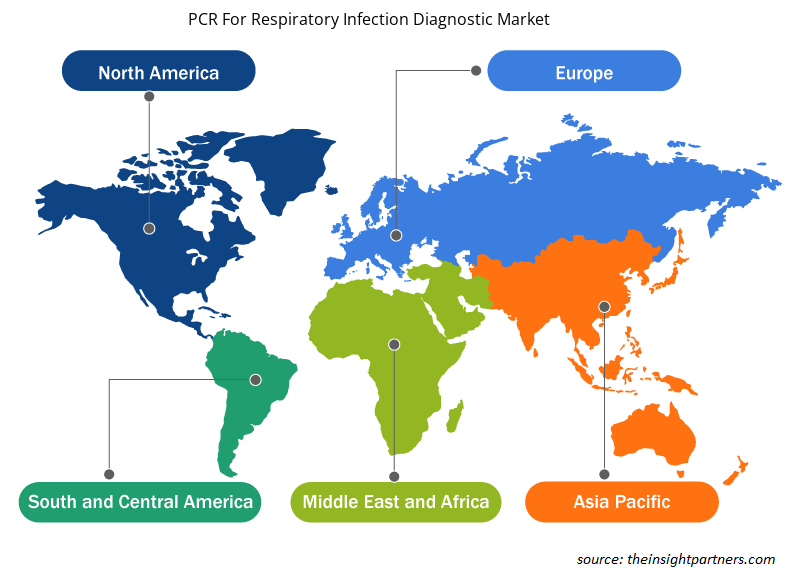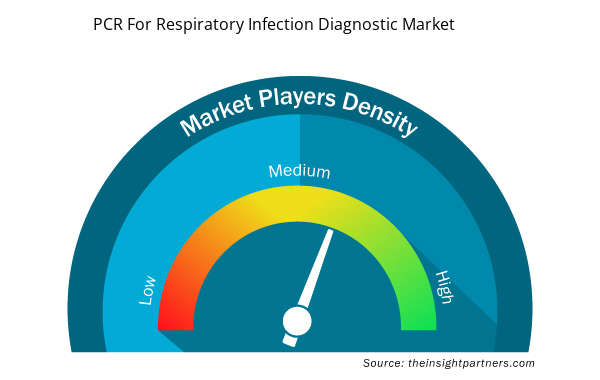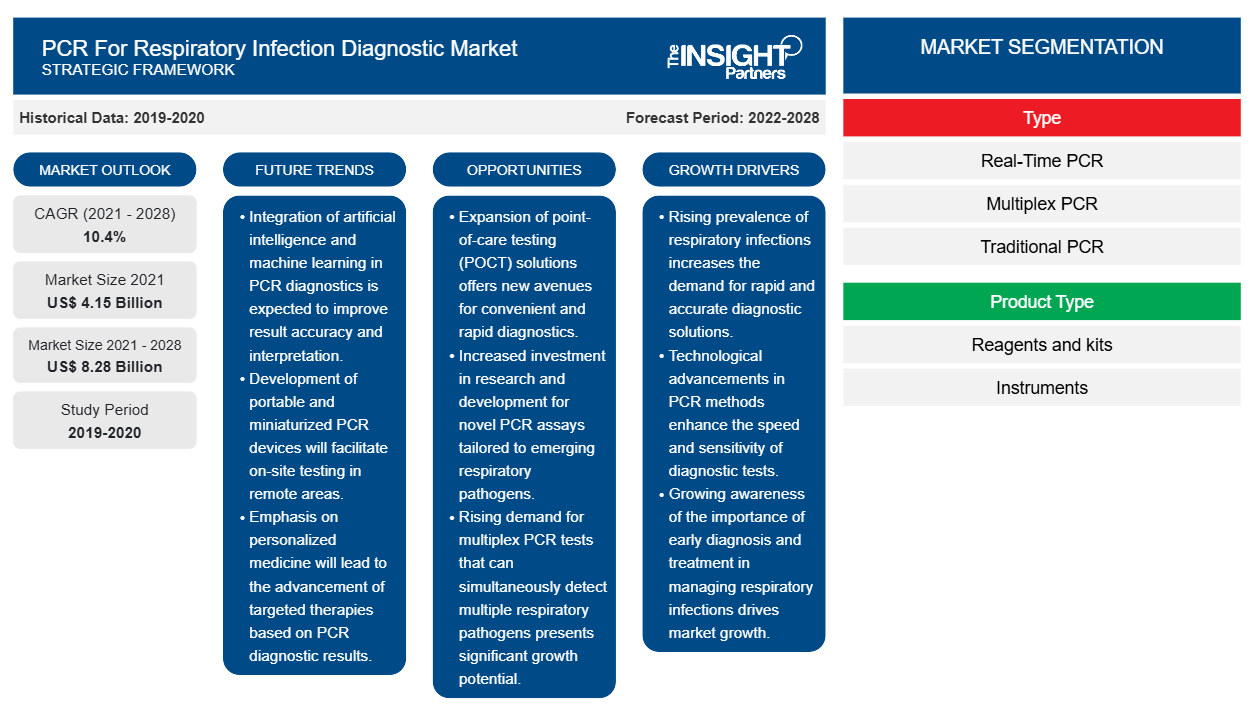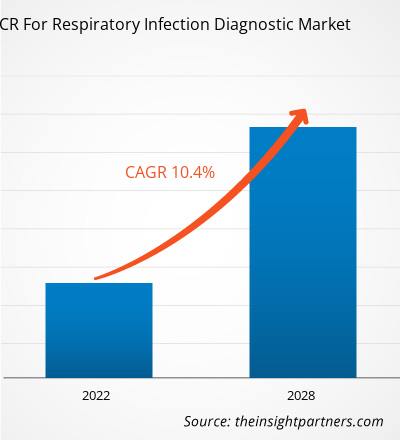到 2028 年,呼吸道感染诊断 PCR 市场价值将从 2021 年的 41.4602 亿美元增至 82.7932 亿美元;预计从 2021 年到 2028 年的复合年增长率为 10.4%。
聚合酶链反应 (PCR) 用于准确的即时诊断,有助于快速识别和确定呼吸道感染的原因。此外,PCR 在住院和门诊环境中广受欢迎,有助于促进近年来市场的增长。
呼吸道感染诊断用 PCR 市场的增长 归因于慢性呼吸道疾病 (CRD) 负担的增加、PCR 检测的不断发展等因素,这些因素正在广泛提高医疗器械的性能。然而,PCR 检测用于各种呼吸道感染诊断,以及用于推导这些诊断的 PCR 技术的发展。替代检测方法的可用性阻碍了市场的增长。
定制此报告以满足您的需求
您可以免费定制任何报告,包括本报告的部分内容、国家级分析、Excel 数据包,以及为初创企业和大学提供优惠和折扣
- 获取此报告的关键市场趋势。这个免费样品将包括数据分析,从市场趋势到估计和预测。
市场洞察
针对各种呼吸道感染诊断的 PCR 检测所采用的市场整合策略
PCR 检测是检测呼吸道传染病(包括 SARS-CoV-2)的金标准。此外,PCR 的不断发展不仅限于 COVID-19 检测。技术的不断发展使研究人员能够以较低的成本开发先进的 PCR 技术并限制其复杂性。随着微流体和下一代测序等技术的不断发展,预计 PCR 检测将增强其分子诊断能力并在未来加强其作用。此外,PCR 检测在疗养院、慢性病护理机构和医院等机构中被广泛用于识别引起呼吸道爆发的流感病毒感染。
此外,急性和慢性呼吸道感染是全球发达国家和发展中国家发病的主要原因之一。据估计,急性呼吸道疾病占全球急性发病率的近 75%。因此,各公司都在提供各种 PCR 试剂盒,用于检测引起呼吸道疾病的病原体的存在。例如,bioMérieux SA 和 altona Diagnostics GmbH 等公司提供各种 PCR 试剂盒,可检测上呼吸道或下呼吸道的急性呼吸道感染。除了急性和慢性呼吸道疾病发病率不断上升外,环境和气候条件、空气污染以及新型细菌、病毒和病原体的发现等其他因素也可能成为未来呼吸道感染诊断 PCR 检测的重要增长机会。
基于类型的洞察
呼吸道感染诊断用 PCR 市场按类型细分为实时 PCR (qPCR)、多重 PCR、传统 PCR、数字 PCR、逆转录酶 (RT-PCR) 等。实时 PCR (qPCR) 细分市场在 2021 年占据了最大的市场份额,预计在预测期内将实现最高的复合年增长率。
基于产品类型的洞察
根据产品类型,呼吸道感染诊断用 PCR 市场细分为试剂和试剂盒、仪器和其他。试剂和试剂盒部分在 2021 年占据了最大的市场份额,预计在预测期内将实现市场最高的复合年增长率。
基于感染类型的见解
根据感染类型,呼吸道感染诊断用 PCR 市场细分为细菌感染、病毒感染以及真菌和其他病原体。2021 年,病毒感染领域占据了最大的市场份额,预计在预测期内将实现最高的复合年增长率。
基于最终用户的洞察
根据最终用户,呼吸道感染诊断用 PCR 市场细分为医院、医生诊所、临床实验室、学术和研究机构、生物技术和制药公司等。2020 年,临床实验室部门占据了最大的市场份额,预计在预测期内将实现市场最高的复合年增长率。
产品发布和审批是企业扩大全球业务和产品组合的常用策略。此外,乳房重建市场参与者专注于合作策略来扩大客户群,这反过来又使他们能够在全球范围内维护自己的品牌。
呼吸道感染 PCR 诊断市场区域洞察
Insight Partners 的分析师已详细解释了整个预测期内影响 PCR 呼吸道感染诊断市场的区域趋势和因素。本节还讨论了北美、欧洲、亚太地区、中东和非洲以及南美和中美洲的 PCR 呼吸道感染诊断市场细分和地理位置。

- 获取呼吸道感染 PCR 诊断市场的区域特定数据
PCR 呼吸道感染诊断市场报告范围
| 报告属性 | 细节 |
|---|---|
| 2021 年市场规模 | 41.5亿美元 |
| 2028 年市场规模 | 82.8亿美元 |
| 全球复合年增长率(2021 - 2028) | 10.4% |
| 史料 | 2019-2020 |
| 预测期 | 2022-2028 |
| 涵盖的领域 | 按类型
|
| 覆盖地区和国家 | 北美
|
| 市场领导者和主要公司简介 |
|
呼吸道感染 PCR 诊断市场参与者密度:了解其对业务动态的影响
呼吸道感染 PCR 诊断市场正在快速增长,这得益于终端用户需求的不断增长,这些需求源于消费者偏好的不断变化、技术进步以及对产品优势的认识不断提高等因素。随着需求的增加,企业正在扩大其产品范围,进行创新以满足消费者的需求,并利用新兴趋势,从而进一步推动市场增长。
市场参与者密度是指在特定市场或行业内运营的企业或公司的分布情况。它表明在给定市场空间中,相对于其规模或总市场价值,有多少竞争对手(市场参与者)存在。
在呼吸道感染 PCR 诊断市场运营的主要公司有:
- 雅培
- F.霍夫曼-罗氏公司
- Hologic 公司
- Seegene 公司
- 澳大利亚诊断公司
免责声明:上面列出的公司没有按照任何特定顺序排列。

- 获取呼吸道感染 PCR 诊断市场主要参与者概览
按类型
- 实时 PCR (qPCR)
- 多重PCR
- 传统 PCR
- 数字 PCR
- 逆转录聚合酶链反应 (RT-PCR)
- 其他的
按产品类型
- 试剂和试剂盒
- 仪器
- 其他的
按感染类型
- 细菌感染
- 博德氏杆菌
- 肺炎链球菌
- 金黄色葡萄球菌
- 流感嗜血杆菌
- 卡他莫拉菌
- 肺炎支原体
- 肺炎衣原体
- 军团菌
- 其他的
- 病毒感染
- 鼻病毒
- 流感病毒
- 严重急性呼吸道综合征(SARS)CoV-2 病毒
- 呼吸道合胞病毒 (RSV)
- 腺病毒
- 肠道病毒
- 副流感病毒
- 人类偏肺病毒 (hMPV)
- 其他的
- 真菌和其他病原体
按最终用户
- 医院
- 医生诊所
- 临床实验室
- 学术及研究机构
- 生物科技和制药公司
- 其他的
按地理位置
- 北美
- 我们
- 加拿大
- 墨西哥
- 欧洲
- 法国
- 德国
- 英国
- 西班牙
- 荷兰
- 挪威
- 意大利
- 欧洲其他地区
- 亚太地区 (APAC)
- 中国
- 印度
- 日本
- 澳大利亚
- 韩国
- 亚太其他地区
- 中东和非洲 (MEA)
- 沙特阿拉伯
- 阿联酋
- 南非
- 中东和非洲其他地区
- 南美洲和中美洲(SCAM)
- 巴西
- 阿根廷
- 南美洲和中美洲其他地区
公司简介
- 雅培
- F.霍夫曼-罗氏公司
- Hologic 公司
- Seegene 公司
- 澳大利亚诊断公司
- 屋宇署
- Bio-Rad 实验室公司
- 生物梅里埃
- Qigen
- 赛默飞世尔科技公司
- 历史分析(2 年)、基准年、预测(7 年)及复合年增长率
- PEST 和 SWOT 分析
- 市场规模价值/数量 - 全球、区域、国家
- 行业和竞争格局
- Excel 数据集



Report Coverage
Revenue forecast, Company Analysis, Industry landscape, Growth factors, and Trends

Segment Covered
This text is related
to segments covered.

Regional Scope
North America, Europe, Asia Pacific, Middle East & Africa, South & Central America

Country Scope
This text is related
to country scope.
常见问题
The growth of the region is attributed to factors such as rising public–private partnerships, and increasing funding activities are widely enhancing the performance of medical devices. Moreover, presence of well-developed healthcare infrastructure and government support are some of the prominent factors propelling the market growth in Asia Pacific. In addition, the Europe is expected account for the fastest growth in the PCR for respiratory infection diagnostics market. A high demand in research, growing support from governments, continuously changing disease profiles, rising public–private partnerships, and increasing funding activities are widely enhancing the performance of medical devices growth of Europe PCR for respiratory infection diagnostics market during the forecast period.
The polymerase chain reaction (PCR) is a simple and low-cost method for amplifying small portions of DNA. Because significant amounts of a sample of DNA are necessary for molecular and genetic analyze, studies of isolated fragments of DNA are almost impossible without PCR amplification.
The growth of the market is attributed to some key driving factors such as as the increasing Burden of Chronic Respiratory Diseases (CRDs), growing developments in PCR testing, are widely enhancing the performance of medical devices. However, use of PCR testing for various respiratory infection diagnostics and developments in PCR technology being used to derive them. The availability of alternative assays hinders the market growth. In January 2020, Roche received CE Mark approval for an adenovirus test for transplant patients. It is intended to be used in conjunction with other infectious diseases tests available on their cobas systems (6800 and 8800). The majority of companies are now offering real-time polymerase chain reaction (PCR) tests for corona virus, which is contributing to the growth of the target market.Such strategic steps are also projected to drive the market growth.
Trends and growth analysis reports related to Life Sciences : READ MORE..
The List of Companies - PCR for Respiratory Infection Diagnostic Market
- Abbott
- F. Hoffmann-La Roche AG
- Hologic, Inc.
- Seegene Inc.
- AusDiagnostics
- BD
- Bio-Rad Laboratories Inc
- BioMérieux
- Qiagen
- Thermo Fisher Scientific Inc
The Insight Partners performs research in 4 major stages: Data Collection & Secondary Research, Primary Research, Data Analysis and Data Triangulation & Final Review.
- Data Collection and Secondary Research:
As a market research and consulting firm operating from a decade, we have published and advised several client across the globe. First step for any study will start with an assessment of currently available data and insights from existing reports. Further, historical and current market information is collected from Investor Presentations, Annual Reports, SEC Filings, etc., and other information related to company’s performance and market positioning are gathered from Paid Databases (Factiva, Hoovers, and Reuters) and various other publications available in public domain.
Several associations trade associates, technical forums, institutes, societies and organization are accessed to gain technical as well as market related insights through their publications such as research papers, blogs and press releases related to the studies are referred to get cues about the market. Further, white papers, journals, magazines, and other news articles published in last 3 years are scrutinized and analyzed to understand the current market trends.
- Primary Research:
The primarily interview analysis comprise of data obtained from industry participants interview and answers to survey questions gathered by in-house primary team.
For primary research, interviews are conducted with industry experts/CEOs/Marketing Managers/VPs/Subject Matter Experts from both demand and supply side to get a 360-degree view of the market. The primary team conducts several interviews based on the complexity of the markets to understand the various market trends and dynamics which makes research more credible and precise.
A typical research interview fulfils the following functions:
- Provides first-hand information on the market size, market trends, growth trends, competitive landscape, and outlook
- Validates and strengthens in-house secondary research findings
- Develops the analysis team’s expertise and market understanding
Primary research involves email interactions and telephone interviews for each market, category, segment, and sub-segment across geographies. The participants who typically take part in such a process include, but are not limited to:
- Industry participants: VPs, business development managers, market intelligence managers and national sales managers
- Outside experts: Valuation experts, research analysts and key opinion leaders specializing in the electronics and semiconductor industry.
Below is the breakup of our primary respondents by company, designation, and region:

Once we receive the confirmation from primary research sources or primary respondents, we finalize the base year market estimation and forecast the data as per the macroeconomic and microeconomic factors assessed during data collection.
- Data Analysis:
Once data is validated through both secondary as well as primary respondents, we finalize the market estimations by hypothesis formulation and factor analysis at regional and country level.
- Macro-Economic Factor Analysis:
We analyse macroeconomic indicators such the gross domestic product (GDP), increase in the demand for goods and services across industries, technological advancement, regional economic growth, governmental policies, the influence of COVID-19, PEST analysis, and other aspects. This analysis aids in setting benchmarks for various nations/regions and approximating market splits. Additionally, the general trend of the aforementioned components aid in determining the market's development possibilities.
- Country Level Data:
Various factors that are especially aligned to the country are taken into account to determine the market size for a certain area and country, including the presence of vendors, such as headquarters and offices, the country's GDP, demand patterns, and industry growth. To comprehend the market dynamics for the nation, a number of growth variables, inhibitors, application areas, and current market trends are researched. The aforementioned elements aid in determining the country's overall market's growth potential.
- Company Profile:
The “Table of Contents” is formulated by listing and analyzing more than 25 - 30 companies operating in the market ecosystem across geographies. However, we profile only 10 companies as a standard practice in our syndicate reports. These 10 companies comprise leading, emerging, and regional players. Nonetheless, our analysis is not restricted to the 10 listed companies, we also analyze other companies present in the market to develop a holistic view and understand the prevailing trends. The “Company Profiles” section in the report covers key facts, business description, products & services, financial information, SWOT analysis, and key developments. The financial information presented is extracted from the annual reports and official documents of the publicly listed companies. Upon collecting the information for the sections of respective companies, we verify them via various primary sources and then compile the data in respective company profiles. The company level information helps us in deriving the base number as well as in forecasting the market size.
- Developing Base Number:
Aggregation of sales statistics (2020-2022) and macro-economic factor, and other secondary and primary research insights are utilized to arrive at base number and related market shares for 2022. The data gaps are identified in this step and relevant market data is analyzed, collected from paid primary interviews or databases. On finalizing the base year market size, forecasts are developed on the basis of macro-economic, industry and market growth factors and company level analysis.
- Data Triangulation and Final Review:
The market findings and base year market size calculations are validated from supply as well as demand side. Demand side validations are based on macro-economic factor analysis and benchmarks for respective regions and countries. In case of supply side validations, revenues of major companies are estimated (in case not available) based on industry benchmark, approximate number of employees, product portfolio, and primary interviews revenues are gathered. Further revenue from target product/service segment is assessed to avoid overshooting of market statistics. In case of heavy deviations between supply and demand side values, all thes steps are repeated to achieve synchronization.
We follow an iterative model, wherein we share our research findings with Subject Matter Experts (SME’s) and Key Opinion Leaders (KOLs) until consensus view of the market is not formulated – this model negates any drastic deviation in the opinions of experts. Only validated and universally acceptable research findings are quoted in our reports.
We have important check points that we use to validate our research findings – which we call – data triangulation, where we validate the information, we generate from secondary sources with primary interviews and then we re-validate with our internal data bases and Subject matter experts. This comprehensive model enables us to deliver high quality, reliable data in shortest possible time.


 获取此报告的免费样本
获取此报告的免费样本